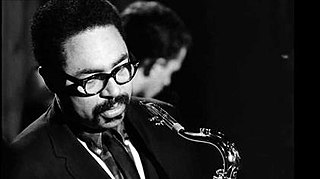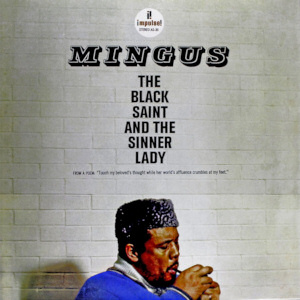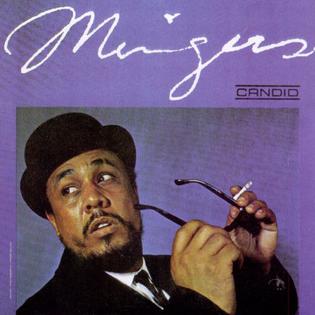
Charles Mingus Jr. was an American jazz double bassist, pianist, composer and bandleader. A major proponent of collective improvisation, he is considered to be one of the greatest jazz musicians and composers in history, with a career spanning three decades and collaborations with other jazz legends such as Louis Armstrong, Duke Ellington, Charlie Parker, Dizzy Gillespie, Dannie Richmond, and Herbie Hancock.

Claire Tomalin is an English journalist and biographer, known for her biographies of Charles Dickens, Thomas Hardy, Samuel Pepys, Jane Austen, and Mary Wollstonecraft.

John Arthur "Jaki" Byard was an American jazz multi-instrumentalist, composer and arranger. Mainly a pianist, he also played tenor and alto saxophones, among several other instruments. He was known for his eclectic style, incorporating everything from ragtime and stride to free jazz.

Booker Telleferro Ervin II was an American tenor saxophone player. His tenor playing was characterised by a strong, tough sound and blues/gospel phrasing. He is best known for his association with bassist Charles Mingus.

Paul Bley, CM was a jazz pianist known for his contributions to the free jazz movement of the 1960s as well as his innovations and influence on trio playing and his early live performance on the Moog and Arp audio synthesizers. His music has been described by Ben Ratliff of the New York Times as "deeply original and aesthetically aggressive". Bley's prolific output includes influential recordings from the 1950s through to his solo piano recordings of the 2000s.
Toby Litt is an English writer and academic in the Department of English and Humanities at Birkbeck, University of London.
Robert Adams Gottlieb is an American writer and editor. He has been editor-in-chief of Simon & Schuster, Alfred A. Knopf, and The New Yorker.

The Black Saint and the Sinner Lady is a studio album by American jazz musician Charles Mingus, released on Impulse! Records in 1963. The album consists of a single continuous composition—partially written as a ballet—divided into four tracks and six movements.

Jack Lesberg was a jazz double-bassist.

John Josephus Hicks Jr. was an American jazz pianist, composer, and arranger. He was leader for more than 30 recordings and played as a sideman on more than 300.

Pithecanthropus Erectus is a 1956 album by jazz composer and bassist Charles Mingus. Mingus noted that this was the first album where he taught arrangements to his musicians by ear in lieu of putting the chords and arrangements in writing.

Mingus Dynasty is a jazz album by Charles Mingus, recorded in 1959 and released on Columbia Records in May 1960. It is a companion album to his 1959 record, Mingus Ah Um, and was inducted in the Grammy Hall of Fame in 1999. The title alludes to Mingus's ancestry which was partially Chinese.

Mingus Moves is a 1973 album by jazz composer and bassist Charles Mingus.

A Modern Jazz Symposium of Music and Poetry is an album by jazz bassist, composer, and band leader Charles Mingus, released by Bethlehem Records in mid-1959. In spite of the title, the album does not contain any poetry. "Scenes in the City", however, includes narration performed by Mel Stewart and written by actor Lonne Elder with assistance from Langston Hughes. The composition "Duke's Choice" re-appears, in updated form, as "I X Love" on the 1963 album Mingus Mingus Mingus Mingus Mingus. "Nouroog", "Duke's Choice" and "Slippers" form the basis of the suite "Open Letter to Duke" on Mingus Ah Um.

Charles Mingus: Triumph of the Underdog is a 1997 documentary film about the life of jazz musician Charles Mingus.
As a bandleader, the American jazz bassist Charles Mingus released 51 albums between 1949 and 1977; as a sideman, Mingus appeared on a total of 34 albums. 4 albums of his music were recorded posthumously between 1979 and 1990.

Mingus is an album by jazz bassist and composer Charles Mingus. The album was recorded in October and November 1960 in New York and released in late 1961 on Nat Hentoff's Candid label.

My Favorite Quintet is a live album by American bassist, composer and bandleader Charles Mingus recorded at Guthrie Theater in Minneapolis and first released on Mingus' own Jazz Workshop label in 1966.

Reginald Volney Johnson was an American jazz double-bassist.

Miles Davis Quartet is a 10 inch LP album by Miles Davis, released in 1954 by Prestige Records. The first four tracks that comprise Side 1 were recorded at New York's WOR Studios, on May 19, 1953. The last three, heard on Side 2, were recorded nearly a year later, at New York's Beltone Studios, on March 15, 1954.

















